
Thijs Biersteker, Wither, 2022. Installation im Japanischen Palais, Dresden. Foto und ©: Thjis Biersteker und Woven Studio.
Voices Mag: Thijs, please explain the premise of “Wither,” a recent work of yours that you’re showing at the Children’s Biennale. What’s the story behind it?
Thijs Biersteker: “Wither” provides an outtake of the rainforest as it disappears in real time, on a rate equivalent to that of the deforestation that is happening on the ground in the Amazon. Every leaf that withers in the sculpture represents the loss of 128 m2 of actual rainforest, a loss in biodiversity the enormity of which the work tries to convey. During the first COVID-19 lockdown there was a 70% increase in the rate of deforestation, a figure so unfathomable that I decided to create a work to help us grasp it on a more relatable, human scale.
Are environmental issues always at the basis of your work?
All my work is made around the crucial issues of climate change, biodiversity loss, pollution and other challenges we’re faced with today. The work is always developed in collaboration with scientists, in the case of “Wither” it builds on data obtained from UNESCO.
How do you address the fact that artworks too have a carbon footprint? Are sustainable and recycled materials something you consider in your own work process?
If the idea is to create work that deals with environmental impact, you’ll have to accept the fact that the work in itself will carry some environmental impact, too. There’s no way of changing the system without being part of it. The question to ask is whether it’s worth it when considered against the gains. Keep in mind that in Woven Studio, the studio we founded, we work as sustainably as possible, that is, with the entire lifecycle of the primary materials in mind. “Wither” is a good example as it employs factory waste and recycled steel in addition to electronic components. Each part is documented in a “material passport” that instructs any future handlers on how to dispose of the work once it’s done its job. And, in addition to our own output, we’re slowly beginning to assist other artists on better practices for sustainable production to shift the needle on that.
Your work is strongly rooted in the notion that art can help change things for the better.
In my view, art is reflective of the times we live in. And this period in time is characterized by enormous challenges which need to be addressed. Art has the power of mediating the greater issues on a scale that is accessible to anyone, helping us all understand the bigger picture. And it’s only once we’ve understood the issues at hand that we can start acting on them.
Your work resonates with both the tradition of conceptual art as that of environmental art. How do you relate to fields of knowledge outside the arts, science in particular?
I believe art and science are really powerful when joined together, because together they speak to the factual side of the brain as well as the emotional. Facts and data are stored in the brain’s memory, but it is the emotional side that triggers action. And that is what we need right now. I think cultural producers, artists, writers and musicians should take it upon themselves to mediate to the wider public the hard data that is coming from the scientific community. That’s why we work together with big universities and research groups to bridge the gap. I think this is our duty as artists.
Thijs, give us a glimpse into the future: What are you currently working on?
Wow. A lot is going on right now. We are working on several new projects at the same time. There are projects on tree-to-tree communication, on mycelium networks that control buildings, and on the real-world pollution generated by digital data. I’m proud that UNESCO has joined us as a partner last month, which is a huge step forward in our ability to access rich and varied scientific data. I don’t know what the future brings, but I’d like to contribute my share in averting a kind of future that no one wants to see coming.


